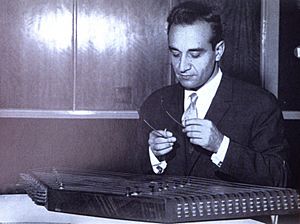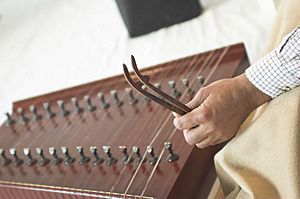Santur facts for kids

Santur (Persian: سنتور) is an Iranian traditional musical instrument. It can also be referred to as santoor or santour. It is usually based on 18 Bridge (Persian: خرک) on the left and right side (9 in left and 9 on the right).
Santoor has 4 strings in each bridge. It is commonly played with two wooden stick named (Persian: مضراب) which has strings usually either white and yellow.
The three different parts provide different tones where the yellow strings which is often the first position, while the white strings being in the second position and the bridge, and lastly the yellow strings behind the bridge.
History
The santur was invented and developed in the area of Iran and Mesopotamia (modern-day Iraq). From there, the instrument was traded and traveled to different parts of the Middle East.
Each country customized and designed its own versions to adapt to their musical scales and tunings. The original santur was made with tree bark and stones, and strung with goat intestines.
The Mesopotamian santur has been claimed to be the father of the harp, the Chinese yangqin, the harpsichord, the qanun, the cimbalom, and the American and European hammered dulcimers
Notable Santoor artists:
- Ardavan Kamkar
- Faramarz Payvar
- Parviz Meshkatian
- Pashang Kamkar
Images for kids
See also
 In Spanish: Santur para niños
In Spanish: Santur para niños





